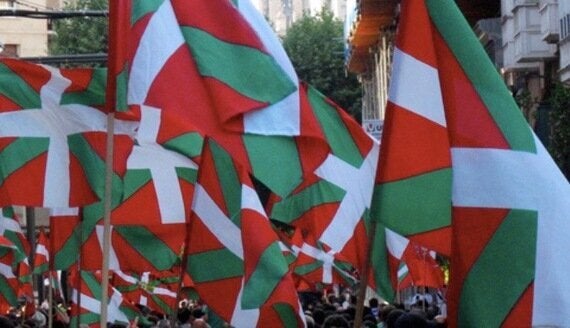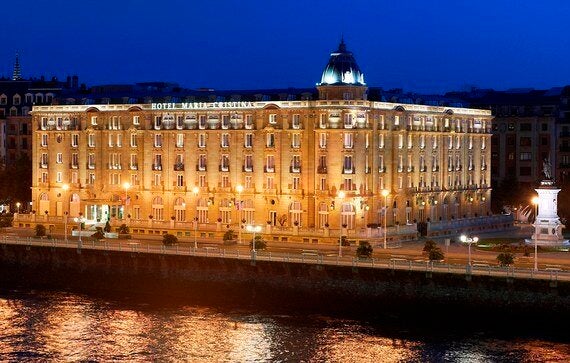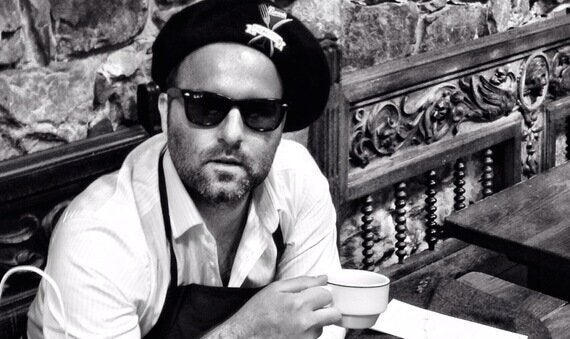I feel at my most Hemingwayesque by morning, when I wake in the Hotel Maria Cristina, the warm sun spilling through the blinds and the fuzzy-tongued roughness of salty anchovies on my breath. I force a shower and some coffee, and stumble out the door, through the lobby, and into the Basque morning for swift replenishment.
I walked along the cobbled República Argentina Kalea and looked up at the high windows and balconies of ornamented apartments, where wet washing dried in the morning sun.
Hanging over one balcony railing was the Basque flag; a flash of red, green, and white flapping in the wind. It reminded me of the time I saw the stripped red and yellow flags of the Catalans in Barcelona, pinned to the windows of apartments and cars, and waving from a flagpole in the grounds of the Montjuïc Castle. Two fiercely independent and autonomous communities, pocketed in agrarian Spain.

The red, green and white flag of the Basque country in San Sebastián during a march. The white cross represents Basque's devotion to the Catholic religion while the red background symbolises the Basque people. The green saltire is a reference to the Oak of Guernica, a symbol of the fueros. © Discoverthebasquecountry.com
Wiping the sweat of Gonzalez Byass and jamón fat from my brow, I make the absurd decision to head for the shore, and to climb Monte Urgull, the 243-metre ridge that stretches out along the coastline, sinking into the Bay of Pasain.
I took the path from the Plaza de Zuloaga and began the hike to the Scared Heart statue at the summit. The 12-metre statue by Spanish artist Federico Coulannt is the city's answer to the epochal Christ the Redeemer, their Angel of the North.
From the summit of Monte Urgull I'm rewarded with views across the bay and a cold, crisp air that's welcomed more than a dose of super-charged Paracetamol. Starring up at the statue, Jesus facing forward and his right-hand pointing skywards, I suddenly feel the dizziness set-in, the morning heat engulf me, and the free-flow Sherry still present in my bloodstream, finally reach my brain.
In the central square are small family-run shops and hole-in-the-wall establishments, piled high with every colourful legume and vegetable conceivable. There are flower stalls and market stalls, and cornucopia spilling with fruit.
Below the central square is the subterranean Mercado de la Bretxa market of a thousand meat, fish, cheese, and confectionary stalls. This is where chefs collect their hake, pargo, pike, squid, and glazed-eyed lamb's heads. There are slabs of meat on counters; hanging jamón, pig's legs, and chorizo sausage, and piles of crushed ice for the morning's catch. It's a labyrinth of delectable treats, and I pick out wonderful examples of hooked and netted fish, unusual examples of seafood specialities, rarely obtainable back home: river crayfish, barnacles, and live baby eels.
By lunch I've found my stride again, suitably replenished post a goats cheese and jamón baguette from La Bretxa Market. Once consumed, I feel rejuvenated, eager to take on my next culinary education.
I met with Eli Susperregui from San Sebastián Food, a local Basque guide company who focus on the region's culinary attractions. Eli has gained me access to one of the city's 119 txokos, a gastronomic society of men who meet to eat, cook, and drink together.
Much like the tale of the Beronia founders and their male-dining club, Bodegas Beronia, txokos began in the mid-19th century in Guipuzcoa. The first in San Sebastián was called La Fraternal and was founded in 1843. Fundamentally, as a result of the decline of the siderias, or cider bars, and the movement of the people from the countryside to the cities.

Hotel Maria Cristina on República Argentina Kalea, San Sebastián. © Hotel Maria Cristina - a Luxury Collection Hotel
All members of a txoko trust each other and hold their own door key to the society; therefore they can enter whenever they wish. For this reason, the entry of new members is highly controlled: old members must introduce a new member, and there is normally the right to refuse admission. Thankfully, I am the guest of Eli and she obviously knows people, the right people. This particular society accept the entry of women, however until recently, women couldn't even enter these secret gastronomic societies, and in many still, they are welcomed, but forbidden to cook.
Once inside I'm given an apron and a Boina, a Spanish beret. An onion is rolled my way to peel. I fulfill my chopping duties, then another is rolled over. A silvery bowl of slippery anchovies is put in front of me, and a burly lady behind the stove gesticulates wildly, mimicking the washing, peeling, and de-boning of the small, jelly-eyed fish.
In truth, I did rather little, but am rewarded with a feast of which I only had a passing hand in. There are the staples, tortilla de potatoes and anchovies with green olives; then layers of thinly-sliced jamón, the silky white fat glistening like marble.

David wearing a Boina in a San Sebastián txoko, one of the 119 secret gastronomic societies in the town. © David J Constable
This is my ideal city. San Sebastián has a spiritual reserve for hospitality. You have the mountains on one side and the sea on the other. In the centre are all of the recognisable commercial amenities we know: the hotels, restaurants, bars, coffee shops, and a first-rate market. It has a warm climate; art, heritage, and tales of the royal family. It boasts the heart and soul of a proud, collective, and self-sufficient small town.
On my final evening, and yet another round of pintxos, local wine, and sherry-soaked hours, I know that again I'll wake with the sea salt freshness of a hundred anchovies on my breath. But I don't care. There's still so much to eat, so much to drink, and there's always that faint whisper on the wind, a whisper of encouragement, a rally of 'Go on my boy, push on...'. That voice of Hemingway, urging me to continue forth, to pursue another drink, another adventure, another rapacious path in this culinary township of splendor.
- - - - -
David stayed at the Hotel Convento San Roque in Biscay, north of Bilbao, and at the Hotel Maria Cristina in San Sebastián.
For more information on Beronia wine and the Bodegas Beronia visit www.beronia.com. For news on Beronia Txokos in the UK visit www.beronia.com/en/txoko
International Sherry Week runs from the 2nd - 8th November 2015. Find out more from González Byass including events in the UK.
San Sebastián Food is the Basque Country's original guide company focused entirely on the region's culinary attractions. They lead culinary tours throughout the Basque Country in northern Spain and southern France, and offer cooking classes and jamón carvings, as well as visits to wineries and local markets. To see a full list of their services and how you can book tours and classes, visit www.sansebastianfood.com.